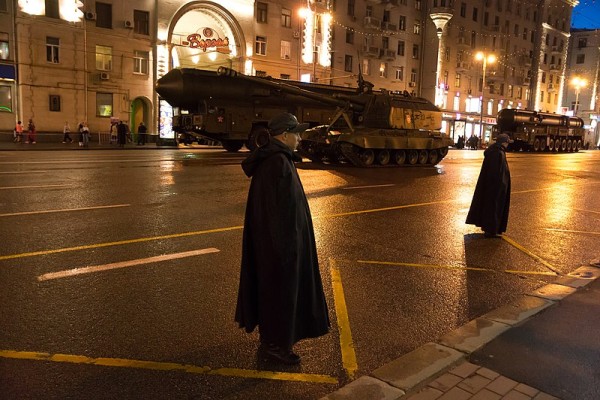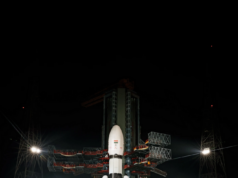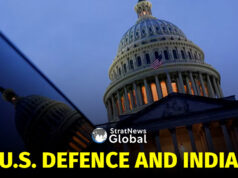The growing deterioration in global security has led to increasing dependence on nuclear deterrence, says the Stockholm International Peace Research Institute (SIPRI).
The SIPRI Yearbook 2024, released on Monday, says the nine nuclear-armed states continued to modernize their nuclear arsenals and deploy new nuclear-armed or nuclear-capable weapon systems in 2023.
‘Of the total global inventory of an estimated 12 121 warheads in January 2024, about 9585 were in military stockpiles for potential use,’ says the report.
At the start of 2024, the 9 nuclear-armed states possessed an estimated 12 121 nuclear weapons. New numbers out now ➡️ https://t.co/hwXGg3URBP
USA🇺🇸 5 044
Russia🇷🇺 5 580
UK🇬🇧 225
France🇫🇷 290
China🇨🇳 500
India🇮🇳 172
Pakistan🇵🇰 170
North Korea🇰🇵50
Israel🇮🇱 90#SIPRIYearbook pic.twitter.com/GEKbCl8vEd— SIPRI (@SIPRIorg) June 16, 2024
‘An estimated 3904 of those warheads were deployed with missiles and aircraft—60 more than in January 2023—and the rest were in central storage. Around 2100 of the deployed warheads were kept in a state of high operational alert on ballistic missiles. Nearly all of these warheads belonged to Russia or the USA, but for the first time China is believed to have some warheads on high operational alert,’ it adds.
‘While the global total of nuclear warheads continues to fall as cold war-era weapons are gradually dismantled, regrettably we continue to see year-on-year increases in the number of operational nuclear warheads,’ said SIPRI Director Dan Smith. ‘This trend seems likely to continue and probably accelerate in the coming years and is extremely concerning.’
According to the report, India, Pakistan and North Korea are all pursuing ‘the capability to deploy multiple warheads on ballistic missiles, something Russia, France, the UK, the USA and—more recently—China already have.’
‘This would enable a rapid potential increase in deployed warheads, as well as the possibility for nuclear-armed countries to threaten the destruction of significantly more targets,’ it says.
The report also notes that Russia and the U.S. together possess almost 90 per cent of all nuclear weapons. ‘The sizes of their respective military stockpiles (i.e. useable warheads) seem to have remained relatively stable in 2023, although Russia is estimated to have deployed around 36 more warheads with operational forces than in January 2023,’ it says.
In addition to their military stockpiles, Russia and the U.S. each hold more than 1200 warheads previously retired from military service, which they are gradually dismantling, it notes.
‘Transparency regarding nuclear forces has declined in both countries in the wake of Russia’s full-scale invasion of Ukraine in February 2022, and debates around nuclear-sharing arrangements have increased in saliency,’ says the report.
Notably, there were several public claims made in 2023 that Russia had deployed nuclear weapons on Belarusian territory, although there is no conclusive visual evidence that the actual deployment of warheads has taken place, it says.
As for China, SIPRI estimates that the size of its nuclear arsenal ‘increased from 410 warheads in January 2023 to 500 in January 2024, and it is expected to keep growing.’
More importantly, ‘For the first time, China may also now be deploying a small number of warheads on missiles during peacetime,’ it notes.
‘Depending on how it decides to structure its forces, China could potentially have at least as many intercontinental ballistic missiles (ICBMs) as either Russia or the USA by the turn of the decade, although its stockpile of nuclear warheads is still expected to remain much smaller than the stockpiles of either of those two countries.’
‘China is expanding its nuclear arsenal faster than any other country,’ said Hans M. Kristensen, Associate Senior Fellow with SIPRI’s Weapons of Mass Destruction Programme and Director of the Nuclear Information Project at the Federation of American Scientists (FAS). ‘But in nearly all of the nuclear-armed states there are either plans or a significant push to increase nuclear forces.’
Another annual report released on the same day as the SIPRI yearbook by The International Campaign to Abolish Nuclear Weapons (ICAN) says $10.7 billion more was spent on nuclear weapons in 2023 than in 2022.
‘In 2023 China, France, India, Israel, North Korea, Pakistan, Russia, the UK and US spent a combined $91.4 billion on their nuclear arms, which breaks down to $173,884 per minute, or $2,898 a second,’ it says.
In a career spanning three decades and counting, Ramananda (Ram to his friends) has been the foreign editor of The Telegraph, Outlook Magazine and the New Indian Express. He helped set up rediff.com’s editorial operations in San Jose and New York, helmed sify.com, and was the founder editor of India.com.
His work has featured in national and international publications like the Al Jazeera Centre for Studies, Global Times and Ashahi Shimbun. But his one constant over all these years, he says, has been the attempt to understand rising India’s place in the world.
He can rustle up a mean salad, his oil-less pepper chicken is to die for, and all it takes is some beer and rhythm and blues to rock his soul.
Talk to him about foreign and strategic affairs, media, South Asia, China, and of course India.





